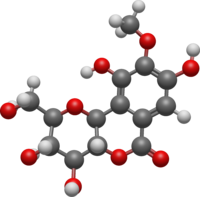Bergenin

| |

| |
| Names | |
|---|---|
| Preferred IUPAC name
(2R,3S,4S,4aR,10bS)-3,4,8,10-Tetrahydroxy-2-(hydroxymethyl)-9-methoxy-3,4,4a,10b-tetrahydropyrano[3,2-c][2]benzopyran-6(2H)-one | |
| Other names
Cuscutin
| |
| Identifiers | |
3D model (
JSmol ) |
|
| ChEMBL | |
| ChemSpider | |
ECHA InfoCard
|
100.230.534 |
PubChem CID
|
|
| UNII | |
CompTox Dashboard (EPA)
|
|
| |
| |
| Properties | |
| C14H16O9 | |
| Molar mass | 328.27 g/mol |
Except where otherwise noted, data are given for materials in their standard state (at 25 °C [77 °F], 100 kPa).
| |
Bergenin, alias cuscutin, is
immunomodulatory effect.[1]
Bergenin can be isolated from Bergenia species like Bergenia ciliata and Bergenia ligulata,[2] from rhizomes of Bergenia stracheyi. It is also found in the stem bark of Dryobalanops aromatica,[3] in Ardisia elliptica and in Mallotus japonicus.[4]
References
External links
 Media related to Bergenin at Wikimedia Commons
Media related to Bergenin at Wikimedia Commons
